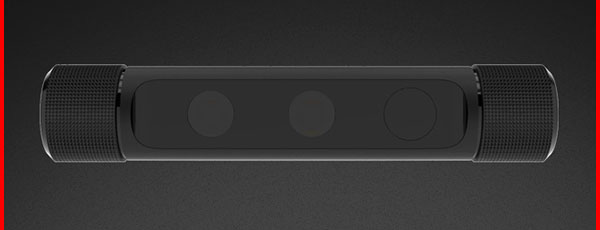Razer on Tuesday introduced a camera that incorporates Intel’s RealSense technology, suggesting use cases as a depth-sensing accessory in PC gaming and beyond.
The company described its camera concept at the Intel Developer Forum in San Francisco, which was chock-full of big announcements.
Intel updated developers on its efforts in the wearables market, and it introduced its solution for security in the Internet of Things space: enhanced privacy identification, or EPID, technology, which will secure IoT devices.
Intel also showed off its pseudo-holographic display with haptic feedback, in a demo featuring a big robotic spider family whose mother sported RealSense camera depth-sensing eyes.
The star of the conference was RealSense and the swarm of related products. Razer’s as-yet-unnamed camera offered one of the most compelling embodiments of RealSense hardware.
The Razer Camera
The Razer camera looks a bit like a scaled-down version of a tabletop Kinect.
It supports head-tracking and 3D-scanning, which could make the camera system especially attractive to developers and content creators.
Its tracking technology can remove the background in video streams — an ability that adds a whole new dimension for Twitch and YouTube broadcasters. With manufacturers of VR headsets working out their own head-tracking solutions, though, Razer’s 3D-scanning capability may be a bigger draw than the camera’s ability to isolate bodies and follow movement.
The camera’s scanning ability allows it to bring real-world objects and bodies into virtual spaces with ease, according to Razer. Those real-world objects could be a clay model for an animated short, a face for a video game, a fragile antique, or any other thing the user desires to map in 3D.
More use cases have yet to be dreamed up, said Razer’s Ruben Mookerjee, VP peripherals.
“Aside from the obvious applications for motion sensing, our RealSense camera will combine depth sensing with a regular front-facing optical image to enable augmented reality type applications, similar to Microsoft’s HoloLens concept,” he told TechNewsWorld.
With Intel preparing to release its latest, high-fidelity RealSense system, Razer wanted to collaborated with the company on a standalone version of the camera for PC, said Mookerjee.
“Having a widely commercially available camera will support the many developers currently working on RealSense apps, and hopefully encourage a few more to join up,” he noted. “A standalone USB peripheral like ours — as opposed to a camera hard-wired into a laptop lid — will give many more end-users an easy way to use RealSense-enabled apps.”
Members of Razer’s team have been collaborating with Intel’s perceptual computing unit for a while, said Mookerjee.
Razer has been intrigued by the implications of RealSense’s depth-sensing tech in gaming and VR, along with its potential as an Internet broadcasting device, he added.
“We are very excited that Intel is now collaborating with us in adapting the RealSense SDK to be part of the [Open Source VR] platform — since it opens up many new possibilities,” he remarked.
With the VR camera available for hands-on time at IDF in San Francisco, there’s been some speculation of an early 2016 release window. Razer has yet to announce a launch date.
VR’s Early Settlers
One thing Facebook’s Oculus VR has made clear: Widespread adoption of VR requires innovation and integration. Razer has partnered with OSVR on a VR headset, and Intel has been collaborating with several other companies on RealSense.
RealSense is Intel’s innovation, and it has been driving integration of the technology.
Intel kept mum about any plans to develop its own RealSense hardware but said it currently is “focused on enabling camera integrators to create USB peripherals based on Intel RealSense technology,” in a statement provided to TechNewsWorld by spokesperson Lindsey Pappas.
The areas where RealSense complements Intel’s other tech — CPU, graphics, memory, security, IoT technology — are effectively limitless, the company noted.
“With integrated Intel RealSense cameras on laptops and all-in-one desktops, and expanding Intel RealSense technology into areas like phones, robots/drones and connected home, there is a wide variety of complementary overlap,” Intel said.
As for Razer, it has been collaborating with several partners on the hardware building blocks with which consumers can build custom VR rigs.
The unnamed RealSense camera will join a Leap Motion-backed unit for hand-tracking, an OSVR-branded VR headset, and the Hydra motion-sensing controller that was developed in collaboration with Sixense.
The blocks Razer and other VR companies have been laying could play defining roles in the development of the industry, where there currently is a huge disparity between supply and demand, according to William F. Zachmann, CEO of Canopus Research.
Razer may have reason to hope that its RealSense camera will do well, but the VR segment hasn’t grown into a mass market just yet, he told TechNewsWorld.
VR “is more important as a developmental technology than it as a widespread market at this point,” Zachmann said, “although it’s starting to climb up the bottom of the S curve, so to say.”




















































